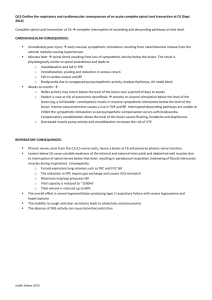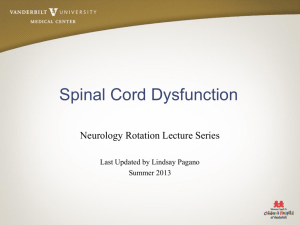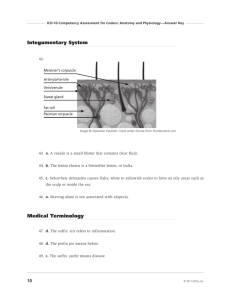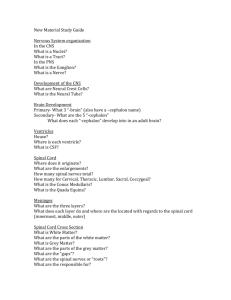Forbes_-_Lesion_Localization
advertisement
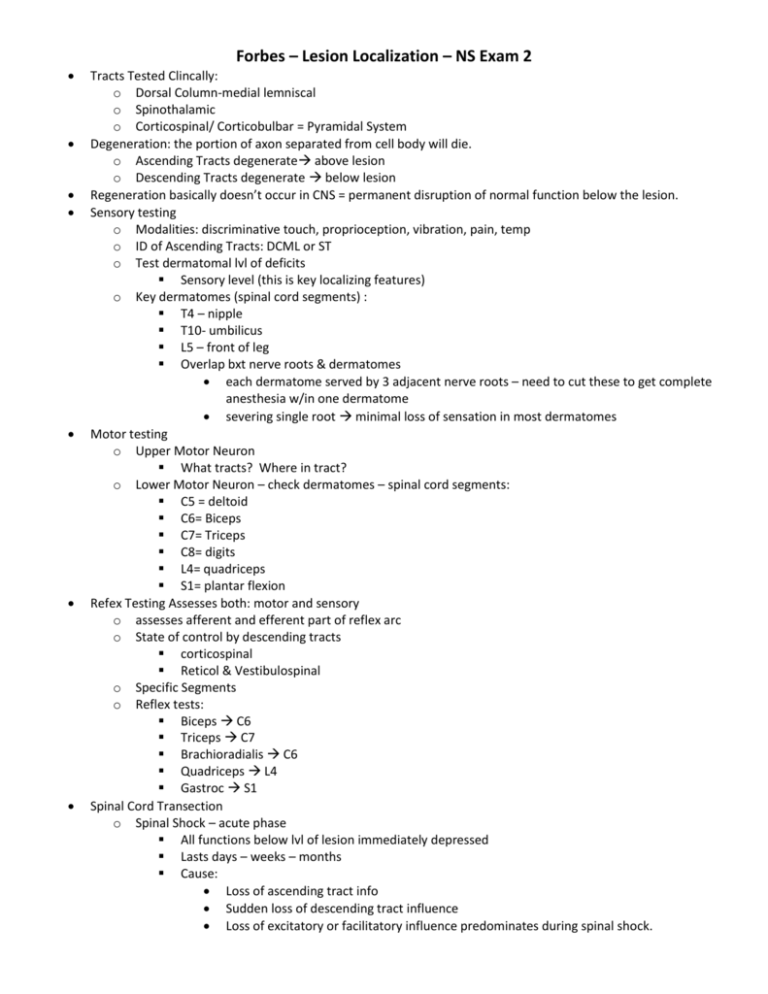
Forbes – Lesion Localization – NS Exam 2 Tracts Tested Clincally: o Dorsal Column-medial lemniscal o Spinothalamic o Corticospinal/ Corticobulbar = Pyramidal System Degeneration: the portion of axon separated from cell body will die. o Ascending Tracts degenerate above lesion o Descending Tracts degenerate below lesion Regeneration basically doesn’t occur in CNS = permanent disruption of normal function below the lesion. Sensory testing o Modalities: discriminative touch, proprioception, vibration, pain, temp o ID of Ascending Tracts: DCML or ST o Test dermatomal lvl of deficits Sensory level (this is key localizing features) o Key dermatomes (spinal cord segments) : T4 – nipple T10- umbilicus L5 – front of leg Overlap bxt nerve roots & dermatomes each dermatome served by 3 adjacent nerve roots – need to cut these to get complete anesthesia w/in one dermatome severing single root minimal loss of sensation in most dermatomes Motor testing o Upper Motor Neuron What tracts? Where in tract? o Lower Motor Neuron – check dermatomes – spinal cord segments: C5 = deltoid C6= Biceps C7= Triceps C8= digits L4= quadriceps S1= plantar flexion Refex Testing Assesses both: motor and sensory o assesses afferent and efferent part of reflex arc o State of control by descending tracts corticospinal Reticol & Vestibulospinal o Specific Segments o Reflex tests: Biceps C6 Triceps C7 Brachioradialis C6 Quadriceps L4 Gastroc S1 Spinal Cord Transection o Spinal Shock – acute phase All functions below lvl of lesion immediately depressed Lasts days – weeks – months Cause: Loss of ascending tract info Sudden loss of descending tract influence Loss of excitatory or facilitatory influence predominates during spinal shock. o Gradual recovery of reflexes after spinal shock Reflex apparatus is still intact so LMNs still get input Modulation or regulation from descending tracts is gone Loss of inhibitory influence comes to predominate (maybe b/c): Vacant synaptic sites on LMNs occupied by new nerve sprouts from primary afferents – so that a sensory stimulus would have greater effect on LMN Denervation hypersensitivity leads to increased responsiveness of LMNs to neurotransmitter Progressive return of reflex activity – from Fitz. o Residual (Chronic) Dysfunction: 1.) UMN deficits below the level of the lesion a.) Spastic paresis/paralysis b.) Marked muscle tone c.) Hyperactive deep tendon reflexes d.) Diaphragmatic palsy if lesion above C4/5 e.) Horner’s syndrome if damage above T2 2.) LMN deficits at the level of the lesion a.) Flaccid paresis/paralysis b.) Reduced muscle tone c.) Hypoactive deep tendon reflexes d.) Neurogenic atrophy e.) Fibrillation With a cord lesion at cervical levels: o UMN deficits in legs o LMN deficits in arms With a cord lesion at lumbar levels: o Both UMN & LMN deficits in legs o LMN deficits predominate since the reflex arc is disrupted.

